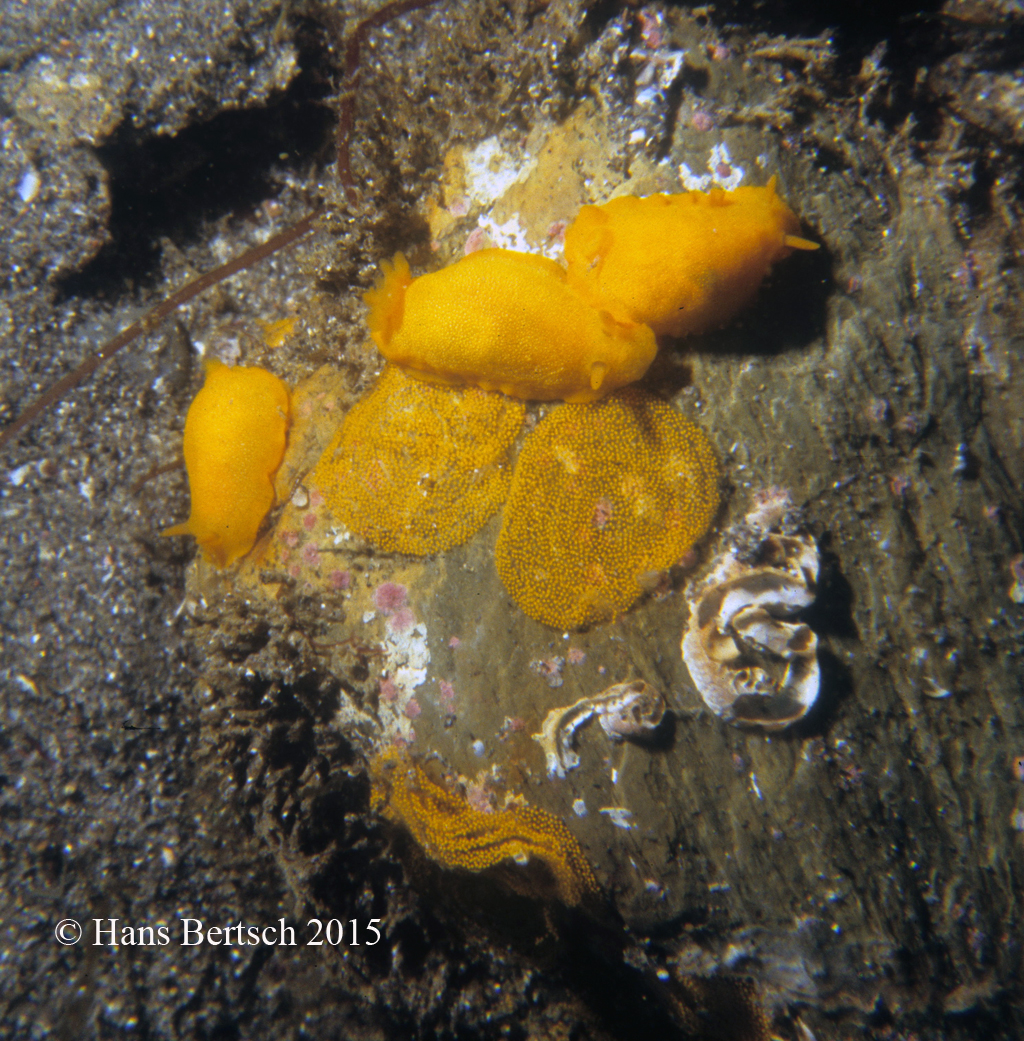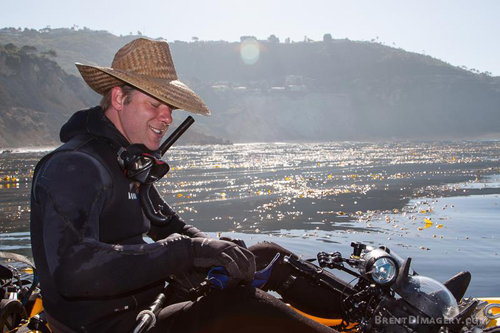 |
Doriopsilla bertschi
Image courtesy of Dr. Hans BertschCuevitas, Bahia de Los Angeles, Baja California
Doriopsilla bertschi (Hoover, Lindsay, Goddard & Valdes, 2015)
Introduction
Ever heard the saying, good things happen in threes? Well, understanding of the biodiversity of porostomes in the Eastern Pacific is experiencing just such a trilogy. Hoover et al (2015) has shown Doriopsilla fulva to be a valid species, the newly described Doriopsilla davebehrensi was featured in BOW week 923, and here we introduce Doriopsilla bertschi.
Morphology
Doriopsilla bertschi is a yellow-orange dorid. The body is relatively elongate and is covered with small white spots that may resemble small dashes with close examination. The gill is very large and is angled towards the posterior.
Size
The size of observed individuals is dependent on season, with the largest individuals located in June and the smallest in September (Bertsch 2002). Doriopsilla bertschi reaches a maximum of 3.5 centimeters in length.
Feeding Habits
Doriopsilla bertschi is a porostome, a type of sea slug that lacks a radula. Instead of scraping and cutting food like other dorids or aeolids, Doriopsillas secrete digestive enzymes onto sponges and suck up the partially digested cells. Doriopsilla bertschi feeds on both the yellow and pink color forms of the sponge Cliona celata (Bertsch pers. comm.).
Distribution
This animal is known only from Bahia de Los Angeles in the Gulf of California, a site that is not known to have Doriopsilla gemela . Range can therefore be used to differentiate between the two species.
Natural History
Lance reported that D. bertschi has direct development, juveniles hatch directly from eggs (unpub data reported in Hoover et al 2015). Considering the limited range observed, this species may have limited dispersal capabilities. This species was not observed on the Midriff Islands during a week-long expedition in July of 2014, though its food source was regionally abundant (Hoover unpub data). The lack of observed D. bertschi on islands in July has several possible causes. Limited dispersal is one possibility. Another possibility involves seasonality. Bertsch (2002) noted that the species is very common at the coastal sites of La Gringa and Cuevitas in Bahia de Los Angeles and documented an annual life cycle there, with a die-off beginning in July. Bertsch did not observe individuals in August. A third possibility is suggested by study of Doriopsilla in other regions. Doriopsilla spp. in Southern California are very common along the coast but seldom if ever observed at Channel Islands such as Catalina and Anacapa (Hoover unpub data). Therefore, seasonality could affect the lack of D. bertschi observations on the Midriff Islands in July; however, larval dispersal, or perhaps differences between coastal and island sites could also be at play.
Etymology
Doriopsilla bertschi is named in honor of the consummate marine biologist from the Gulf of California, Dr. Hans Bertsch. Through this name we celebrate Hans' passion for study and conservation of biodiversity in the Gulf of California, his dedication to scientific communication, and mentorship of multiple generations of marine biologists. Hans' work is compelling; teaching about the people, culture and history of Mexico in addition to the biodiversity found there. Few teachers present such a multidimensional view, and we are grateful to share Hans' inspiration.
Synonymy
Prior to studies by Hoover et al (2015) both D. gemela and D. bertschi were classified as D. gemela (Gosliner et. al. 1999). In fact, photos in the popular identification guides by Hermosillo et al (2006), Behrens & Hermosillo (2005) and Kerstitch & Bertsch (2007) that indicate D. gemela are actually D. bertschi. See the addendum to this page for a pictorial comparison of D. bertschi and D. gemela.
References
Behrens D. W., Hermosillo A., 2005. Eastern Pacific Nudibranchs, A Guide to the Opisthobranchs from Alaska to Central America. Sea Challengers, 4 Sommerset Rise, Monterey, CA 93940.
Bertsch H. 2002. The natural history of Doriopsilla gemela Gosliner, Schaefer and Millen, 1999 (Opisthobranchia: Nudibranchia), at Bahia de los Angeles, Baja California, México. Western Society of Malacologists Annual Report, vol. 33, p. 8.
Gosliner T. M., Schaefer M. C. & Millen S. V., 1999. A new species of Doriopsilla (Nudibranchia: Dendrodorididae) from the Pacific coast of North America, including a comparison with Doriopsilla albopunctata (Cooper, 1863). The Veliger, 42, 201-210.
Hermosillo A., Behrens D. W., Rios Jara E., 2006. Opistobranquios de Mexico, Guia de babosas del Pacífico, Golfo de California y las islas oceanicas. Direccion de Artes Escenicas y Literatura, Universidad de Guadalajara, Simon Bolivar # 194, Guadalajara, Jalisco, México.
Hoover C, Lindsay T, Goddard H R, Valdes A. 2015. Seeing double: pseudocryptic diversity in the Doriopsilla albopunctata-Doriopsilla gemela species complex of the north-eastern Pacific. Zoologica Scripta, DOI: 10.1111/zsc.12123.
Kerstitch A., Bertsch H., 2007. Sea of Cortez Marine Invertebrates 2nd Edition. Sea Challengers, 4 Sommerset Rise, Monterey CA 93940-4112.
Cal Poly at Pomona, Calif
June, 2015
Send Craig email at crghvr@yahoo.com
Craig Hoover on location
 |
Hi branchers. My name is Craig Hoover. I am a graduate student in the lab of Dr. Angel Valdes at Cal Poly Pomona. My M.S. thesis examines biogeographical patterns in sea slugs that range through both the temperate north-eastern Pacific and the Sea of Cortez using molecular techniques. In this process, we have discovered and named the new species, Doriopsilla davebehrensi. Here is an autobiographical account of what led me to study these animals and name this one in honor of Dave. My explorations of the aquatic realm began when I was a child fishing in the cold and swift waters of rivers in the Sierra Nevada Mountains. I became a snorkeler and free diver by age ten, and discovered the wonders of marine life as a teen. I began free diving Malibu in my 20s, and saw my first nudibranch, a Spanish shawl, at Leo Carillo State Park. What a glorious little creature! I learned to scuba dive a year later, in 2004, and continued exploring California's coast each weekend. In 2005, I opened a college catalog to see what would be required to realize a career merging education with marine biology. I traced my finger through the pages all the way back to Introductory Algebra. As a guitar teacher 27 years old, the process seemed daunting, but I have always met challenges with enthusiasm because each brings me closer to my goal. |
My fascination with nudibranchs became a regular hobby in 2009 when I found an old worn original copy of Pacific Coast Nudibranchs (Behrens 1980) at the back shelf of a shelf in ALOHA divers. Though it was a 'shop copy,' the price tag was still there and I talked the owner into selling it to me. This copy still holds a treasured spot on my shelf.
Porostomes are especially interesting. This genus is abundant in Malibu, and a certain yellow-gilled porostome was listed as undescribed (Behrens 1980). Perhaps I have a contribution to make, I thought, as I filled notebooks with detailed observations. Years later, through the help of Jeff Goddard, Angel Valdes, and Hans Bertsch, this has come true. I am happy to continue to follow this path among such excellent company, and name Doriopsilla davebehrensi in honor of the man whose work originally inspired me to become a brancher.
Behrens D. W. 1980. Pacific Coast Nudibranchs: A Guide to the Opisthobranchs of the Northeastern Pacific. Sea Challengers, 1851 Don Avenue, Los Osos, California 93402.

|
